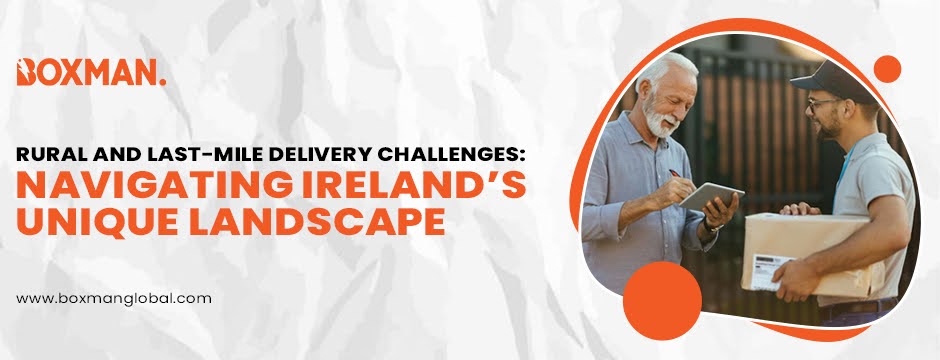
Delivering parcels in rural areas presents unique challenges, particularly in Ireland, where the landscape is as diverse as beautiful. As online shopping grows, the demand for efficient and reliable delivery services has skyrocketed. Last-mile delivery to rural areas poses significant hurdles for companies offering a courier from or to Ireland. In this blog, we will delve into the challenges couriers face in Ireland’s rural regions and explore how innovative solutions and strategic partnerships are transforming the last-mile delivery experience.
Understanding Last-Mile Delivery in Rural Ireland
Last-mile delivery refers to the final step of the delivery process, where a parcel is transported from a distribution center to the recipient’s doorstep. This process is relatively straightforward in urban areas, with well-maintained roads, clear addresses, and concentrated delivery zones. However, the situation is markedly different in rural areas, especially those in Ireland.
The Rural Reality
Ireland's rural landscape is characterized by narrow, winding roads, sparse populations, and areas that can be quite remote. In such settings, last-mile delivery becomes not just a logistical task but a significant challenge. Here are some of the key difficulties faced:
1. Inaccessible Roads and Remote Locations:
Many rural roads in Ireland are not designed for large delivery vehicles. They can be narrow, unpaved, and winding, making navigation difficult, especially in adverse weather conditions. This can lead to increased delivery times and the need for specialized vehicles that can handle such terrain.
2. Sparse Population and Long Distances:
Unlike urban areas, where multiple deliveries can be made over a short distance, rural areas often involve long drives between delivery points. This increases fuel costs and reduces the number of deliveries that can be made daily, impacting overall efficiency.
3. Inaccurate Address Information:
Many rural homes need precise addresses. Some might rely on local landmarks, which are only sometimes recognized by standard GPS systems. This can lead to misdeliveries, increased time spent locating addresses, and frustration for couriers and customers.
4. Limited Delivery Infrastructure:
In rural areas, there are often fewer local delivery hubs or depots, meaning that parcels must travel further before they even begin the last-mile journey. This can cause delays and reduce the speed at which deliveries can be processed and dispatched.
How Couriers Are Addressing These Challenges
Despite these challenges, couriers from Ireland are adopting several innovative strategies and technologies to improve last-mile delivery in rural areas. Here’s how they are tackling the issue:
1. Leveraging Local Partnerships:
One of the most effective ways couriers improve rural delivery is through local partnerships. By collaborating with local businesses and community members, couriers can gain better insights into the unique challenges of specific areas. For example, local post offices or small businesses can act as collection and distribution points, reducing the distance parcels need to travel and ensuring they reach their destination more efficiently.
These partnerships are particularly valuable for services that offer courier to Ireland from international locations. Local knowledge can help navigate tricky routes and ensure that parcels are delivered to even the most remote locations.
2. Utilizing Advanced Technology:
Technology is pivotal in overcoming last-mile delivery challenges. GPS systems and route optimization software are becoming increasingly sophisticated, allowing couriers to plan the most efficient routes and avoid problematic roads. Some couriers even use drone technology to deliver to extremely remote locations that are otherwise inaccessible by vehicle.
Additionally, real-time tracking and communication systems enable couriers to provide customers with accurate delivery windows and updates, enhancing the overall customer experience.
3. Adopting Flexible Delivery Models:
Flexible delivery models, such as parcel lockers and pickup points, are also gaining popularity in rural areas. These solutions provide customers with convenient, central locations to collect their parcels, reducing the need for home deliveries and reducing the time and resources required for last-mile delivery.
For those seeking a reliable courier from Ireland, these flexible models offer the added benefit of convenience and reliability. They ensure that parcels are always accessible, regardless of the recipient's location.
4. Investing in Specialized Vehicles:
Given the challenging terrain of rural Ireland, some couriers are investing in specialized vehicles designed for rough roads and long distances. These vehicles are more fuel-efficient and can navigate narrow, unpaved roads, ensuring that parcels can be delivered promptly, even in adverse conditions.
Electric vehicles are also becoming viable for rural deliveries, as they offer a sustainable alternative to traditional delivery trucks. With advancements in battery technology, electric vehicles can now travel longer distances on a single charge, making them ideal for rural deliveries.
The Role of E-commerce and Changing Consumer Expectations
As e-commerce continues to grow, consumer expectations around delivery are also changing. Customers now expect fast, reliable, and sometimes same-day delivery, regardless of location. For rural residents in Ireland, this expectation presents a unique challenge for couriers, who must balance the need for speed with the realities of rural logistics.
1. The Rise of E-commerce in Rural Ireland:
Online shopping has become increasingly popular in rural Ireland, offering residents access to more products than they might find locally. This has driven the demand for reliable delivery services, forcing couriers to expand their operations and improve their efficiency in rural areas.
2. Meeting Customer Expectations:
To meet these evolving expectations, couriers must adopt a customer-centric approach, emphasizing transparency, reliability, and flexibility. This means providing accurate delivery estimates, offering multiple delivery options, and ensuring that customers are informed throughout the delivery process.
Future Trends in Rural Last-Mile Delivery
Looking ahead, several trends are likely to shape the future of last-mile delivery in rural Ireland:
1. Increased Use of Automation and Robotics:
Automation and robotics are set to play a larger role in last-mile delivery. Autonomous delivery vehicles and drones can transform the delivery landscape, making reaching remote locations easier and more cost-effective.
Adopting these technologies could mean faster, more reliable deliveries for couriers from Ireland, even to the most inaccessible areas. By reducing the reliance on human drivers, companies can cut costs and increase efficiency, passing these benefits on to the consumer.
2. Greater Focus on Sustainability:
Sustainability is becoming a key focus for many courier companies, with an increasing emphasis on reducing carbon emissions and minimizing environmental impact. This is particularly relevant in rural areas, where long delivery routes can contribute significantly to a courier's carbon footprint.
Couriers are exploring various ways to improve sustainability, from investing in electric and hybrid vehicles to optimizing delivery routes to reduce fuel consumption. As consumer awareness around environmental issues grows, couriers prioritizing sustainability will likely gain a competitive edge.
3. Enhanced Collaboration and Shared Networks:
Collaboration between different courier companies and shared delivery networks could help improve efficiency and reduce costs. By pooling resources, couriers can optimize delivery routes, reduce the number of vehicles on the road, and ensure that parcels are delivered quickly and efficiently.

For companies offering courier to Ireland , this collaborative approach can help streamline international shipping processes, ensuring that parcels are delivered to their final destination as quickly and cost-effectively as possible.
Conclusion
The challenges of last-mile delivery in Ireland’s rural areas are significant but not insurmountable. By leveraging local partnerships, embracing technology, adopting flexible delivery models, and investing in specialized vehicles, couriers are finding innovative ways to navigate Ireland’s unique landscape and meet the needs of rural residents.
As e-commerce grows and consumer expectations evolve, the demand for reliable rural delivery services will only increase. Couriers from Ireland and those offering courier to Ireland must continue to adapt and innovate, ensuring that they can provide a service that is both efficient and sustainable.
At Boxman Global , we are committed to overcoming the challenges of rural delivery and ensuring that every parcel reaches its destination, no matter how remote. By staying ahead of industry trends and investing in the latest technology, we are dedicated to providing our customers with the highest level of service, both in Ireland and beyond. Whether you send a parcel across the country or worldwide, you can trust Boxman Global to deliver.